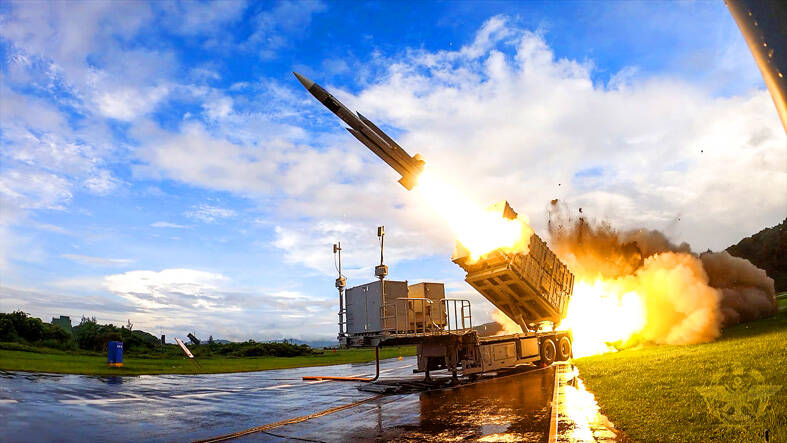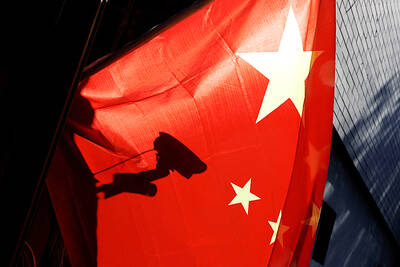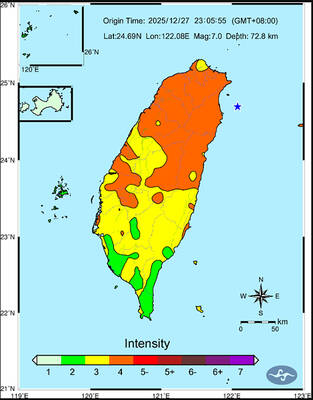The Ministry of National Defense plans to increase the production of anti-ship missiles from this year to 2025 to bolster the nation’s maritime defenses, an official said yesterday.
The extended-range variant of the Hsiung Feng III anti-ship missile is entering mass production this year, while the production volume of the Hsiung Feng II and the base model of the Hsiung Feng III is to be ramped up, the official said, speaking on condition of anonymity.
The estimated cost for the missiles this year is NT$15.5 billion (US$497.83 million), rising to NT$19.8 billion next year before peaking at NT$22 billion in 2025, they said.

Photo: EPA-EFE / Ministry of Defense / Handout
The ministry’s plan to increase its supply of anti-ship missiles comes as the Chinese People’s Liberation Army Navy accelerates its shipbuilding programs and conducts military exercises in the waters around Taiwan, they said.
The military considers anti-ship missiles the most direct and effective weapon system to check Chinese naval forces, the official said, adding that missile systems are to be deployed throughout the nation.
The Hsiung Feng II missile variant has a standard engagement range of 148km, while the new variant of the Hsiung Feng II missile being produced has a range of 160km to 200km, improved maneuverability and its electronic countermeasures are on par with Western systems, they said.
The Hsiung Feng III currently being used has a standard engagement range of 150km to 200km, while the extended-range variant has an effective range of 400km, the official said.
The improved Hsiung Feng III missiles are expected to significantly boost the engagement range of the nation’s anti-ship weapons and enhance the military’s ability to strike targets in seas to the north, south and east of Taiwan proper, they said.
The nation is on track to produce more than 1,000 anti-ship missiles by 2026, which is the last year of the Sea-Air Combat Power Improvement Plan, the ministry told the legislature in a previous report.
The defense industry has the capacity to produce 201 missile systems per year, including 131 Hsiung Feng II or Hsiung Sheng missiles, which share an assembly line, and 70 Hsiung Feng III missiles of the base or extended range variant, it said.

A magnitude 7.0 earthquake struck off Yilan at 11:05pm yesterday, the Central Weather Administration (CWA) said. The epicenter was located at sea, about 32.3km east of Yilan County Hall, at a depth of 72.8km, CWA data showed There were no immediate reports of damage. The intensity of the quake, which gauges the actual effect of a seismic event, measured 4 in Yilan County area on Taiwan’s seven-tier intensity scale, the data showed. It measured 4 in other parts of eastern, northern and central Taiwan as well as Tainan, and 3 in Kaohsiung and Pingtung County, and 2 in Lienchiang and Penghu counties and 1

FOREIGN INTERFERENCE: Beijing would likely intensify public opinion warfare in next year’s local elections to prevent Lai from getting re-elected, the ‘Yomiuri Shimbun’ said Internal documents from a Chinese artificial intelligence (AI) company indicated that China has been using the technology to intervene in foreign elections, including propaganda targeting Taiwan’s local elections next year and presidential elections in 2028, a Japanese newspaper reported yesterday. The Institute of National Security of Vanderbilt University obtained nearly 400 pages of documents from GoLaxy, a company with ties to the Chinese government, and found evidence that it had apparently deployed sophisticated, AI-driven propaganda campaigns in Hong Kong and Taiwan to shape public opinion, the Yomiuri Shimbun reported. GoLaxy provides insights, situation analysis and public opinion-shaping technology by conducting network surveillance

‘POLITICAL GAME’: DPP lawmakers said the motion would not meet the legislative threshold needed, and accused the KMT and the TPP of trivializing the Constitution The Legislative Yuan yesterday approved a motion to initiate impeachment proceedings against President William Lai (賴清德), saying he had undermined Taiwan’s constitutional order and democracy. The motion was approved 61-50 by lawmakers from the main opposition Chinese Nationalist Party (KMT) and the smaller Taiwan People’s Party (TPP), who together hold a legislative majority. Under the motion, a roll call vote for impeachment would be held on May 19 next year, after various hearings are held and Lai is given the chance to defend himself. The move came after Lai on Monday last week did not promulgate an amendment passed by the legislature that

AFTERMATH: The Taipei City Government said it received 39 minor incident reports including gas leaks, water leaks and outages, and a damaged traffic signal A magnitude 7.0 earthquake struck off Taiwan’s northeastern coast late on Saturday, producing only two major aftershocks as of yesterday noon, the Central Weather Administration (CWA) said. The limited aftershocks contrast with last year’s major earthquake in Hualien County, as Saturday’s earthquake occurred at a greater depth in a subduction zone. Saturday’s earthquake struck at 11:05pm, with its hypocenter about 32.3km east of Yilan County Hall, at a depth of 72.8km. Shaking was felt in 17 administrative regions north of Tainan and in eastern Taiwan, reaching intensity level 4 on Taiwan’s seven-tier seismic scale, the CWA said. In Hualien, the